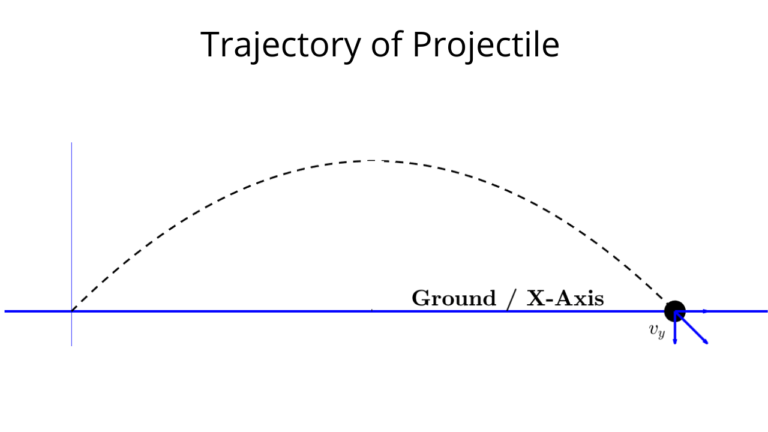When someone talks about relative projectile motion, they typically would either mean, relative position i.e. position of one projectile relative to another or they would mean relative velocity of one projectile relative to other projectile.
As for relative acceleration, i.e. acceleration of a projectile relative to another projectile, if both the projectiles are moving under gravitational force and if we can neglect all ‘other forces’ (for example air drag), then the relative acceleration of one projectile with respect to other would be zero.
Now let’s begin with an example, wherein, we will determine the relative position of one projectile with respect to another
Relative Projectile Motion - Example 1 | Relative position
In this scenario, mass $A$ has been projected vertically upwards from a height $H$, with an initial velocity $u_A$, at $t=0$, while, mass $B$ has been released (with $u_B=0$) at $t = 0$ and we have to determine the relative position of $A$ with respect to $B$, i.e. we need to determine $y_{AB}=$ $y_A-$ $y_B$
Let’s choose the origin of coordinate system at the point of launch with positive axis $y$ pointed upwards. So, as long as both of them are in flight,
$y_A =$ $u_A t -$ $\cfrac{1}{2} g t^2$
$y_B =$ $0.t -$ $\cfrac{1}{2} g t^2$
So, $y_{AB}= y_A – y_B = u_A t$ i.e. $y_{AB}$ vs $t$ curve would be a straight line
Now at $t = \sqrt{\cfrac{2H}{g}}$, mass $B$ reaches the ground and becomes stationary, i.e. after that point $y_B = -H$, and $y_{AB}$ at this point in time would be $u_A \sqrt{\cfrac{2H}{g}}$
So, for $t \geq \sqrt{\cfrac{2H}{g}}$, $y_{AB}= y_A – y_B = u_A t – \cfrac{1}{2} g t^2 + H$, i.e. after $t \geq \sqrt{\cfrac{2H}{g}}$, $y_{AB}$ vs $t$ curve would be an inverted parabola curve.
Now let’s examine relative velocity, i.e. velocity of one projectile with respect to another
Relative Projectile Motion - Example 2 | Relative Velocity
Well remember that relative velocity of projectile $A$ with respect to projectile $B$, $\overrightarrow{V}_{AB}$ is simply $\overrightarrow{V}_{A} – $ $\overrightarrow{V}_{B}$
Now, $\overrightarrow{V}_{A} (t)= $ $u_A \cos \theta_A \hat{i} +$ $(u_A \sin \theta_A – gt) \hat{j}$
& $\overrightarrow{V}_{B} (t)= $ $u_B \cos \theta_B \hat{i} +$ $(u_B \sin \theta_B – gt) \hat{j}$
So, $\overrightarrow{V}_{AB} (t)= $ $(u_A \cos \theta_A – u_B \cos \theta_B) \hat{i} +$ $(u_A \sin \theta_A – u_B \sin \theta_B) \hat{j}$
With that, now let’s look at a scenario where in two projectiles have been launched at different points in time and we have to find $\Delta t$ between their launches for them to collide mid air.
Relative Projectile Motion - Example 3 | $\Delta T$ between launch
So given that two projectiles $A$ and $B$ have been launched from the same point with same initial speed $u$ but launched at different times and different angles, $A$ launched at say $60^\circ$ from the horizontal and $B$ launched horizontally, find the time difference between their launches.
Well let’s say that $B$ was launched with a delay of $\Delta t$ from the time of launch of $A$ and let’s say that they meet / collide at $(x_p, y_p)$, then the four equations involving displacements that will come in handy are:
$A$: $x_p = u \cos 60 t$, with $t$ measured from the time of launch of $A$
$A$: $y_p = u \sin 60 t – \cfrac{1}{2} gt^2$
$B$: $x_p = u (t-\Delta t)$
$B$: $y_p = 0.(t-\Delta t) – \cfrac{1}{2} g(t-\Delta t)^2$
Solving these equations will give us $\Delta t$, $t$, $x_p$ and $y_p$.
Projectile Motion | Important Questions | JEE PYQs
- Types of projectile motion
- Equations of projectile motion
- Range of a projectile
- Maximum height of a projectile
- Trajectory of a projectile
- Radius of curvature of projectile
- Velocity of projectile at time $t$ or height $h$
- Projectile Motion Examples
- Projectile motion along an inclined plane
- Relative motion of projectile(s)
Kinematics Overview – What you need to know for JEE Main and JEE Advanced




